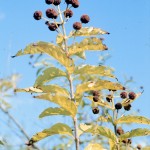Buttonbush
Cephalanthus occidentalis
Rubiaceae
Description
Buttonbush is an upright, many-branched shrub or small tree, usually about 10 feet tall but ranging from 3 to 20 feet or 0.9 to 6 meters in height. Key identifying characteristics are its swollen base, elongated lenticels, and the pincushion appearance of its flowers. The new twigs are green and mature to a reddish-brown. Leaves are variable, often lance-shaped, up to 6 inches or 20 cm long by 7.5 cm wide and are attached often in whorls of three or opposite at each node. They are dark green and shiny above, with acuminate or acute apices and simple, deciduous, and have entire margins. The unique flowers are arranged spherically, forming white balls about 1 inch or 3 cm in diameter. These flowers have many 6 mm, white flowers with four petals, four sepals, and whose stamens with bright yellow anthers extend well beyond the flower throats. Long styles make the flowers appear to be a pincushion. Flowering occurs from June to September with fruits of 2 to 4 nutlets maturing from September to October. These fruits are dark-brown and persist into winter. Then, this bush is reduced to branches tipped by dark brown fruits. Buttonbush is browsed by deer, and 25 species of birds eat its nutlets. It is also a great source of nectar. Besides these exceptional wildlife benefits, it can be a soil stabilizer in riparian areas and makes an attractive ornamental for wet areas.Habitat
Buttonbush is found in swamps, moist low-lying or irrigated areas, and margins of streams throughout the state. In fact, it can tolerate three feet of water and is intolerant of dry soil.Toxic Agent
The toxic agent has not been established. However, early work from Europe has suggested a glycoside principle may be involved. This bush is very unpalatable, so consumption and poisoning are unlikely. Many overgrazed pastures will have untouched Buttonbush along streams. Cattle are thought to be the only species affected. Robert Vines in Trees, Shrubs, and Woody Vines of the Southwest says the bark contains “cephalanthin.”Signs of Livestock Ingestion
Signs of poisoning are not well documented but may include: Vomiting; Paralysis; Muscle spasms.Management Strategies
The plant is not palatable; therefore, good grazing management should prevent any problems. Severe starvation conditions must be present for cattle to consume Buttonbush.Images
Plant Characteristics
Flower Color: White
Seed Type: Fruit/Berry
Duration: Perennial
Stem Texture: Hairless/Smooth
Growth Habit: Shrub (Woody)
Leaf Shape
 : Simple with Pinnate or Parallel Venation
: Simple with Pinnate or Parallel Venation
Season: Warm
Distribution
 : 01 - Pineywoods, 02 - Gulf Prairies and Marshes, 03 - Post Oak Savannah, 04 - Blackland Prairies, 05 - Cross Timbers and Prairies, 06 - South Texas Plains, 07 - Edwards Plateau, 08 - Rolling Plains, 09 - High Plains, 10 - Trans-Pecos
: 01 - Pineywoods, 02 - Gulf Prairies and Marshes, 03 - Post Oak Savannah, 04 - Blackland Prairies, 05 - Cross Timbers and Prairies, 06 - South Texas Plains, 07 - Edwards Plateau, 08 - Rolling Plains, 09 - High Plains, 10 - Trans-Pecos
Distributions
Distribution refers to the ecological region in Texas that a plant has been found. You can also view a clickable map.
Book: Toxic Plants of Texas (B-6105)
Collection: Toxics




